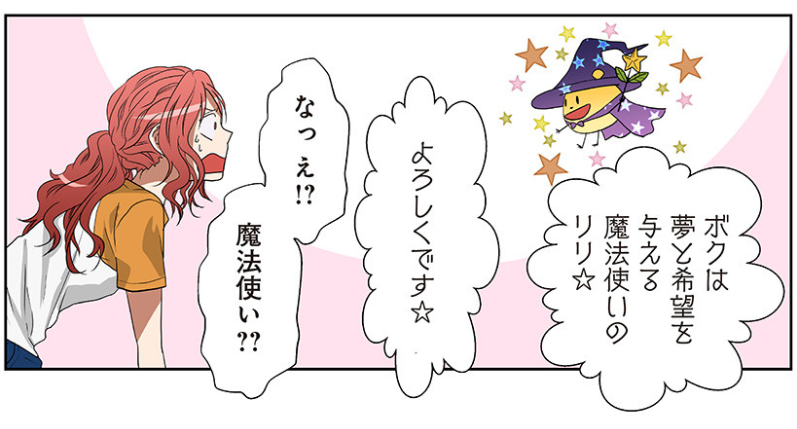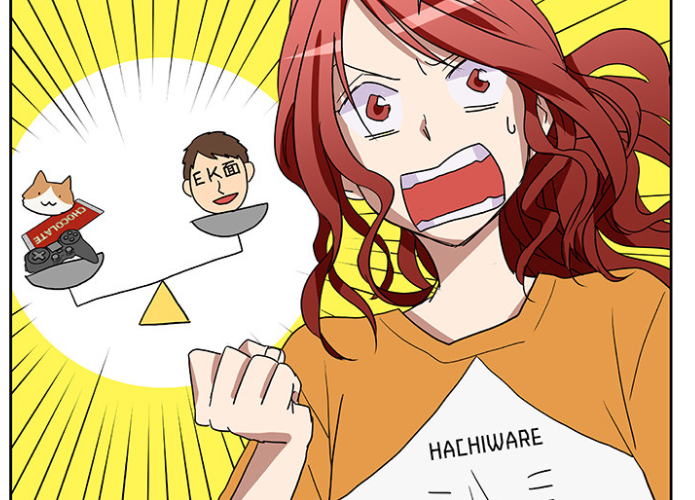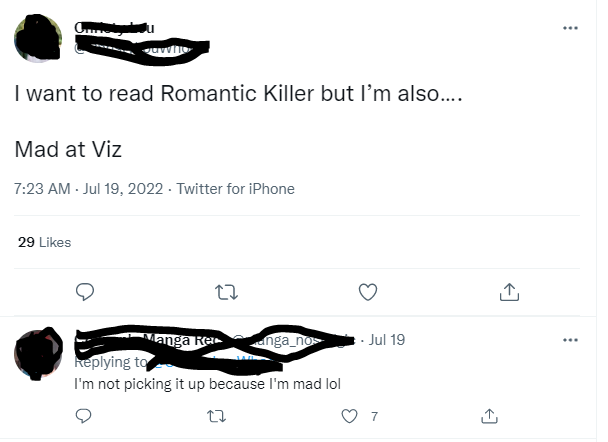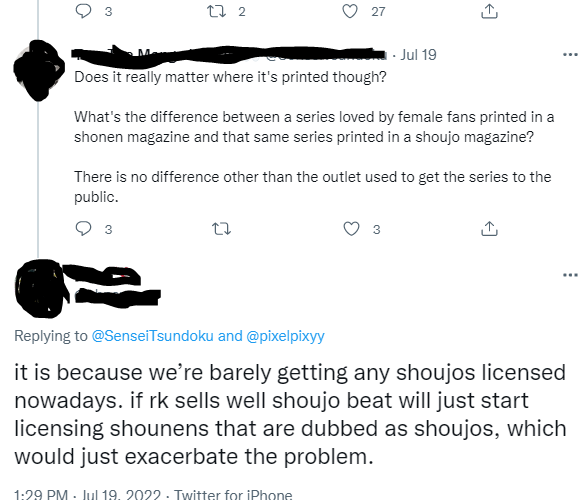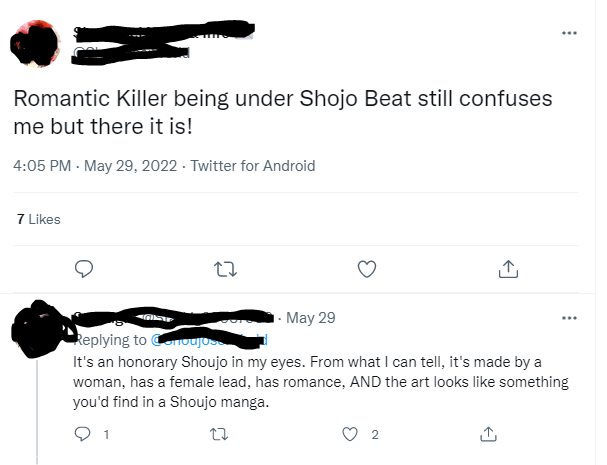Should Shojo Beat grow up?
- That Manga Hunter
- Aug 24, 2022
- 16 min read
An appreciation (and rant) post 18 years in the making
(Note: for my sanity, I'm just going to spell "shojo" and "shonen" without the "u" like VIZ does just for this post.)

In July 2023, Shojo Beat will celebrate its 18th birthday,18 years of entertaining English-language shojo fans. 18 years. Cue Urge Overkill.
The imprint Shojo Beat boasts of being "the leader in shojo manga" with its catalog of "character-driven romance, fantasy, and comedy for teens and adults." The brand is a part of VIZ Media, LLC, an American manga publisher, anime distributor, and entertainment company. The brand has a page on VIZ's site as well as active Tumblr and Twitter accounts to interact with fans.
Well, one day, the Shojo Beat Twitter account asked a simple question: "When did you start reading Shojo Beat manga?"
The poll collected 1,094 votes, and ~36% of voters said 2005 and 26% said 2010. Those fans, myself included, are adults now; some have been for a long time. So, it begs the question, should Shojo Beat grow with fans and license more mature series or stay true to their core audience of 13-19 year-olds?
Before I answer that question, I'd like to discuss the history of Shojo Beat, take a close look at the catalog, and talk about the broader shojo/josei landscape.
Shojo Beat the Magazine
On February 8, 2005, VIZ sent out a press release announcing the launch of Shojo Beat magazine. That's right. The Shojo Beat imprint we know and love today started its life as a 300-page monthly magazine. The first issue hit newsstands in July 2005 with a cover price of $5.99 and a special six-month introductory annual subscription of $29.95. Modeled after its older brother Shonen Jump magazine, which VIZ released in the states from November 2002-April 2012, Shojo Beat featured serialized chapters from six manga series, as well as articles on Japanese culture, manga, anime, fashion, and beauty. The manga was from Japanese publishers Shogakukan, Inc. and Shueisha, Inc. (both parent companies of VIZ), and Hakusensha, a subsidiary of Shueisha.

VIZ trumpeted Shojo Beat as "the only dedicated monthly shôjo magazine offered in North America, and the first time a single manga publication will contain serialized titles from three different Japanese publishers." They were confident in the magazine being a success while capturing and capitalizing on the trend of female teenagers and young adults reading manga, and for all of the magazine's faults, at worst being "a teenie-bopper magazine," the publication did capture an audience. According to the 2008 media kit, Shojo Beat experienced a 75% growth rate since 2005. In 2008, the circulation was 38,000 reaching an estimated audience of 128,421, consisting mostly of female readers between 13-19. (The median age was 18.) 51% of purchases came from subscriptions. The other 49% bought the magazine from newsstands in places like Borders, Waldenbooks, Barnes & Noble, and Wal-Mart.
Honestly, I'm the worst person to talk to about the magazine. I share the same "teenie-bopper magazine" sentiments. I was 16 and a budding anime and manga fan back in 2005, and I was part of the audience that Shojo Beat was trying to capture, and at the same time, I wasn't, judging by the reader profile they cobbled together. I'd rather read manga by the book rather than by magazine. My online activity didn't consist of MySpace, Tumblr, and the dedicated Shojo Beat website. I wasn't interested in fashion or makeup, outside of "Midnight Cowboy" by Urban Decay, and I was not the "Trendsetter" in my group of friends. I did love to read manga among other stuff I did, like suck at volleyball. (I'd love to hear about your fond memories of the magazine below or via Twitter tho!)
Anyway, taking a trip down memory lane is interesting because we get to see some of the nuts and bolts. As far as why the Shojo Beat magazine shutdown is a mystery... or is it? According to a press release, VIZ cited "economic reasons" for the magazine's closure. VIZ released the 49th and final Shojo Beat magazine in July 2009. After the magazine's closure, Shojo Beat lived on as the premiere imprint for shojo manga, and considering a lot of people still look to Shojo Beat to release the hottest and most desired titles, I'd say they succeeded at that.

The Shojo Beat Catalog
As I mentioned in my intro, Shojo Beat (SB) describes its catalog as "character-driven romance, fantasy, and comedy for teens and adults." This translates to lots, and lots, of romance-first series. The full current list of Shojo Beat titles can be found via their website, which I have screenshot and archived here (8/16/22) for discussion. Some series, like Angel Sanctuary, Banana Fish, Basara, From Far Away, and Red River, pre-date the brand, and while filed away with the rest, the manga doesn't bear the "SB" logo. Others, like Please Save My Earth, aren't part of the brand label at all, but shojo fans might associate it with the brand anyway. Few, like Crimson Hero and Black Rose Alice, are completely out-of-print and no longer licensed. Popular works include Vampire Knight, Ouran High School Host Club, Skip, Beat, Yona of the Dawn, Black Bird, Nana, and Fushigi Yugi.
At any rate, there are currently over 140 series. (Note that Rainbow Days and My Special One haven't been added to the site yet.) I can't claim to have read everything nor do I want to, but if you want to read and collect everything under the label, then check out this post on Reddit. As of this post, I have read and completed 31 series. I am presently reading and collecting Skip, Beat, Yakuza Lover, Rosen Blood, and Fushigi Yugi: Byakko Senki. Of the series Shojo Beat recently announced, I am planning to read and possibly collect Romantic Killer, more on that later.
Like many readers, Shojo Beat introduced me to shojo and josei manga. In brief, shojo and josei (and their counterparts shonen and seinen) are demographic labels. Shojo targets teens and young girls. Josei targets women. (There's a little more to it than just marketing, like the types of characters, tropes, and stories one finds in each of these manga and the magazines they're serialized in. Even the art style is different. Plus, there's overlap between the shojo and josei labels, but all of that is best saved for another time.)
My favorite shojo mangaka is Yuu Watase, and I have read almost all of her English-licensed works. My faves include the Fushigi Yugi series and Absolute Boyfriend. Additionally, I love Skip, Beat. I started reading Skip, Beat, a few years back, and it instantly became my #1 favorite shojo. It's funny, smartly written, and the art is beautiful. Nevertheless, my favorite Shojo Beat title goes to Butterflies, Flowers by Yuki Yoshihara, which is the first josei manga released under the imprint.
As I mentioned in my previous post, Butterflies, Flowers is the perfect flavor of raunchy romcom for me, and I am sad that Shojo Beat never released another Yuki Yoshihara manga. As a consolation prize, I know it didn't bomb on arrival when vol. 1 hit store shelves in late 2009. According to the acquisition Tumblr post, Butterflies Flowers was successful enough for Shojo Beat to release more mature manga, which explains how Black Bird, Yakuza Lover, Ohmi Tomu and Maki Enjoji's works, and Everyone's Getting Married co-exist with fluffy fare like My Love Story!! and My Love Mix-Up!. The mature titles are also mixed in with works perfect for younger audiences, like Sugar Princess: Skating to Win, Ultra Maniac, and most of Arina Tanemura's works. Yakuza Lover definitely is the spiciest title in the catalog, but Butterflies, Flowers has Yakuza Lover beat for "most offensive" manga in the catalog. I'll gladly die on that hill.
As explained in the same Tumblr post, readers' interests skew towards fantasy, supernatural, and vampire series which explains why there are 22+ series in this area compared to normal, slice-of-life or school fare. In other words, Shojo Beat will ultimately do what makes dollars and cents, the same as any other publisher out there. So what are the other publishers doing?

Shojo Beat vs. The World
The Intro
A lot has changed since 2005. Borders and Waldenbooks conglomerate is no more. Tokyopop along with Digital Manga Publishing (E-Manga) have fallen and risen from the ashes of the great manga and anime crash of the late 00s/early 10s. Hachette Book Group and Kadokawa Corporation jointly own Yen Press. Kodansha absorbed Vertical Inc. and redesigned their website and logo, and Seven Seas still remains the largest independent U.S. manga publisher. Covid is a thing and f*cking up lives and the supply chain. Demand for manga has increased significantly. Manga is big now. But even with all of these changes, some things still remain the same. Negative attitudes towards shojo and josei manga seem to remain the same. They get amplified daily thanks to social media.
You can talk to these naysayers/shonen fanboys all you want, even have receipts to back it up, and it won't make a difference to some of them. Some people just don't see the value in engaging with media written and intended for women, girls, and ladies at heart. Now, it's one thing when an internet rando is dismissive of shojo/josei manga, but it's a whole other thing when the publisher does it, which brings the conversation back to the elephant in the room.
Shojo Beat vs. The Fans
It's no secret that some shojo/josei fans are upset concerning Shojo Beat's lackluster announcements this past year. In February 2022, VIZ and Shojo Beat announced Rainbow Days and Romantic Killer on Twitter. In brief, VIZ describes Rainbow Days as "Four male friends support each other through the colorful ups and downs of teenage love." Rainbow Days ran in Bessatsu Margaret between 2012-2016. The series is complete at16 volumes, and the series received an anime adaptation in 2016. So, it's old. Appreciated but old nonetheless.
On the other hand, Romantic Killer is a 4-volume, full-color fantasy romcom that ran on Shonen Jump+ in Japan from 2019-2020. That's right. Shojo Beat is releasing a shonen series. As I mentioned in my upcoming releases post, I'm interested in Romantic Killer because of hot guys (it's a reverse harem!), video games, and a full-color release, but I'm not a fan of rebranded shojo/josei series when there are tons of old and new series that ran online or in magazines aimed at women. Plus, it's unfair and insulting.
For example, VIZ's Shonen Jump library has Boys Over Flowers S2 even though the original series is a well-known shojo. Boys Over Flowers S2 ran in Weekly Shonen Jump, but for some reason, VIZ can't extend the same courtesy to Romantic Killer because... why? It's too "girly"? At least, if VIZ released it on the SJ app, I could read it as intended: on my phone for a nominal fee. (BTW—The manga will retail for $16.99/vol because it will be printed in color. This makes it the only full-color manga in the Shojo Beat catalog as well as the most expensive series by single volumes. Most single-volume manga is $9.99/vol. ~yay~)
Romantic Killer by Wataru Momose (Shonen Jump+)
Reactions to Shojo Beat licensing Romantic Killer
Defenders are quick to point out that the mangaka said it's a shojo, and the series has girly themes. "It's an honorary shojo!" "It has a girl protagonist!" "There's romance!" Look, those sorts of arguments, especially "the shojo feel" and "romance," are how people confuse Horimiya, The Apothecary Diaries, Kaguya-sama Love is War, and Monthly Girls Nozaki-Kun for shojo. All great series. They deserve love and praise, but this doesn't help in begging publishers to print works from shojo/josei-targeted magazines and sites if people generally don't care and can't be bothered to understand the difference. Why ask for Coca-Cola when there's Shasta Cola at home? Ok, bad analogy because Shasta is nasty, and I don't want to drink it, but I wouldn't mind reading Romantic Killer, which feeds into the problem. If only there was an anime adaptation, then I could just watch that instead...
Reading dilemma aside, another thing VIZ and Shojo Beat did to piss off shojo fans is announce 1, and only 1, shojo title early summer this year, and that title was My Special One by Momoko Koda. My Special One is an ongoing romcom serialized in Bessatsu Margaret. VIZ describes the story: "A girl who has sworn off beautiful boys meets a gorgeous pop star determined to win her heart!" (Momoko Koda is the same mangaka behind No Longer Herione, which Yen Press will release in September 2022.) As if that wasn't enough, VIZ shared all romance manga news in the r/shoujo subreddit with the asinine title "[NEWS] Just Announced! New Shojo Titles from VIZ."

Finally, the unsafe clusterf*ck known as Anime Expo 2022 came and went, but we got good news. Yen Press announced Honey Lemon Soda, a long-running and award-winning popular manga turned live-action film that hits sales charts every time a new volume drops, and Kodansha licensed two titles The Yakuza's Bias (print) and My Wonderful World (digital). Seven Seas announced the most shojo and josei titles and surprised everyone by licensing Do Not Say Mystery, a popular and award-winning manga turned TV drama that stays on the weekly Oricon sales charts. Having promised fans that more manga news and shojo licenses were coming (but not specifying a date) via Twitter, people were looking forward to what VIZ may announce. So, imagine the disappointment when VIZ announced no new manga licenses.
VIZ has lost shojo/josei fans' trust, but maybe they can win them back with big licenses like 7 Seeds or Colette wa Shinu Koto ni Shita. If history is any indicator, we can expect more manga news from VIZ at Anime NYC 2022. Perhaps, it's time for Shojo Beat to relinquish its crown as "the leader" in shojo because fans have more choices now in who to ask for licenses and what to look forward to release-wise.
Shojo Beat vs. The Other Publishers
The shojo/josei landscape is vastly from 2005. Shojo Beat has stiff competition today. Seven Seas is bringing the booty literally with the new Steamship imprint. I can't stop, won't stop, gushing about physically buying smut, female-gazey romance manga. I love it. Additionally, Seven Seas has licensed a lot of shojo/josei manga, but you wouldn't know unless you look up the titles. Titles include The Seven Princes and the Thousand-Year Labyrinth, The Case Files of Jeweler Richard, Doughnuts Under a Crescent Moon, BL Metamorphosis, The Cornered Mouse Dreams of Cheese, Devils and Realist, Merman in My Tub, I Am a Cat Barista, Box of Light, Even Though We're Adults, Blank Canvas, Red Riding Hood and the Big Sad Wolf, and more. These series are filed elsewhere on the site. Give them a try if you're inclined. (The shojo/josei tag seems mostly dedicated to "stereotypical," and "obvious"-looking series. Lots of m/f romance and some classic manga can be found under the tag.)
Moving on, Kodansha has the best shojo/josei library in breadth and depth. It's not all romance titles. Also, there is a good ratio of spicy and sweet series. The only issue is that you'll have to like digital as Kodansha is extremely risk-averse. Anything remotely not deemed to push units gets sent to digital jail. Uber annoying but makes for lots of hidden gems to explore. Kodansha releases at least one shojo/josei title a month, thanks to digital jail. However, I noticed that Kodansha lags behind in GL, BL, and LGBTQ content compared to Seven Seas. Seven Seas has the most of any big publisher. The point goes to Seven Seas in that area.

Everyone is quick to put down Kodansha, but I'll give them this. At least, Kodansha's manga is accessible. I have the choice to either buy an e-book, ask my library to buy the e-book, or read via the numerous subscription services. Because...If you think Kodansha's digital jail is bad, wait until I tell you about all of the subscription services out there. I mean, have you seen the pricing schemes of these sites!? It makes me want to throttle anyone complaining about the $2/month, a la carte price tag of VIZ's Shonen Jump app or the still completely free Shueisha MangaPlus service.

Meanwhile, shojo/josei fans have to jump from service to service. If you're up for a hunt, you can sift through 300+ manga over on Renta. Hidden gems include Black Sesame Salt and Custard Pudding. BL publisher Futekiya adds several titles a month. Coolmic has smutty josei series. Newcomer MangaPlaza picked up Plus-sized Misadventures in Love!, Make-Up With Mud, and other interesting series. Comikey has Promise Cinderella and The Ice Guy and His Cool Female Colleague. MangaUp! has My Ex-Boyfriend Loves Boys' Love! and Strawberry Love. Tapas has Do You Remember Me?, and WEBTOON has A Fake Affair. Both series are by one of my favorite mangakas Akiko Higashimura, and they are in need of rescuing. Those are just the series and sites that I have my eyes on.
Fellow Hunters, there are dozens of hidden gems and desirable manga to be had on these platforms, and the number grows every day. There's no putting the genie back in the bottle when it comes to digital-only and digital-first publishing. Only the "best" (the most popular and sales-worthy, really) make it out of digital jail. Most are in there for life. Honestly, it's getting harder for me to answer the very real question, "Would you rather have the manga licensed as a digital-only release or never licensed at all?" Because digital subscription exclusives suck and don't come cheaply for the consumer, especially if you're a shojo/josei fan, and while e-books are better IMO, they aren't exactly a bulletproof solution either.

Steering the conversation back to print, the newcomers and younger publishers are picking up older series and classic manga. Glacier Bay Books is publishing the 80s mystery shojo series Star Clock Liddel for the first time in English. Denpa has a growing Moto Hagio collection, with They Were Eleven slated as their latest release. Besides Hagio, Denpa has Maiden Railways and Waltz. Udon Entertainment has classics like The Rose of Versailles. One Peace Books picked up a more recent series (comparatively speaking) Ustoki Rhetoric, much to my delight. Finally, big publisher Yen Press has some stuff, too. They license a lot of works from Monthly Comic Gene, Shueisha, Shogakukan, Hakusensha, and Kadokawa. So, lots of cross-over with VIZ and Shojo Beat.
With all that said, let's circle back and finally answer my question, "Should Shojo Beat grow up?"

Should Shojo Beat Grow Up?
No. Thanks for coming to my Ted Talk.
Okay, I joke. Just hear me out.
Yes, I'd love to see Shojo Beat obtain more mature works. It'd also be great if they did squeeze a few more non-romance series into the catalog. However, Shojo Beat shouldn't change drastically and appeal to an older audience because they do a really good job introducing people to shojo and josei manga. They have something for everybody in their catalog. The titles they license work for them.
Instead, I'd rather see VIZ change its attitude towards Shojo Beat. VIZ needs to grow and appreciate its Shojo Beat audience and fans. They should stop underestimating the Shojo Beat audience and fans. VIZ should regard us as serious consumers like they do their Shonen Jump audience and fans. For one thing, we don't scream incessantly and rudely for two years for a physical release of Mission: Yozakura Family online...but maybe we should adopt some of those tactics because apparently, it works. Not only for VIZ, but this tactic also works for Seven Seas and Kodansha as seen with Tokyo Revengers and Blue Lock. Or maybe it just seems that way. Maybe the publishers were wheelin' and dealin' behind-the-scenes while people are being hella impatient. (Who knows really?) Case in point:

Check out the responses to these two tweets:
(All of this deserves its own post and maybe I'll write one, but for now this is just a taste of what happened online. And for all of these motherf*ckers that screamed about wanting a print license, it's not winning if you don't show up for every, single volume. Every. Single. Volume. Prove the publisher wrong. The same goes to the shojo/josei fans pining for Honey Lemon Soda and Do Not Say Mystery. Though the burden of proof is much, much higher, as publishers don't have faith in us, no way. )

Or this? All of the volumes are like this. It's insane.
Back to the discussion at hand—
At some point, the VIZ Shojo Beat audience is going to grow and ask for mature series, stories following adult characters doing stuff. (Hell, I did at 19 when I picked up Butterflies, Flowers, and it opened up my eyes. I saw the sign.)

In those cases, VIZ should steer them toward the Signature line. VIZ needs to beef up the Signature line, which they currently describe as "Bringing classic and cutting-edge graphic novels to an audience of discerning readers hungry for sophisticated stories and superlative art." The imprint has over 80 series (archived here for discussion 8/17/22) and no identity. Unlike the Shonen Jump and Shonen Sunday imprints, it's not full of action/adventure series, mostly from magazines and websites related to the respective brands in Japan, and unlike Shojo Beat, VIZ Signature is not full of romance either.
VIZ Signature is made up of mature or advent-garde series across demographics, genres, and art styles that just don't fit anywhere else. These books are oversized and receive special treatment like French flaps, hardcovers, omnibus editions, color pages, and textured covers, and they come with a hefty price tag. So why not license more "unconventional" shojo and josei manga and park them there? Some current series include Children of the Whales and Ooku: The Inner Chambers. The latest entry will be Mermaid Scales and the Town of Sand by Yoko Komori, which VIZ announced back in February 2022. Perhaps, this is where Romantic Killer should have been placed. (Also, it'd be great if VIZ gave Banana Fish the Signature treatment.)

Alternatively, maybe it's time that VIZ made a new imprint with a strong identity free of demographic labels and connotations where manga from multiple magazines and online sites can co-exist together. Perhaps, they should make a new romance imprint, like a mixture of Shojo Beat and the cross-appeal romances found in Shonen Jump and Shonen Sunday with a smattering of the least spiciest titles found in Seven Seas' Ghost Ship and Steamship imprints. (VIZ is on the conservative side of publishing as demonstrated by Ayakashi Triangle and other controversies.) This imprint, called "VIZ Romance," would appeal to older teens and adults and be the perfect place to park Romantic Killer as well as their other recent romantic licenses The Girl That Can't Get a Girlfriend, Love in Sight, and Insomniacs After School.

Conclusion
In closing, Shojo Beat has come a long way and still has much to offer old and new fans alike, even if they're disappointing them right now. Shojo Beat still has some of the most popular titles, and their catalog has something for everyone, but competitors, especially Seven Seas and Kodansha, are threatening to take away Shojo Beat's leadership status by publishing more and diverse shojo/josei titles.
Seven Seas is doing something VIZ can never do, by brazenly publishing smut and mature romance and other manga under their numerous imprints, especially Steamphip, and Kodansha is publishing their most popular or marketable shojo/josei in print while releasing their more niche stuff digitally. By putting their works out as e-books and via subscription services, Kodansha is making shojo and josei works more accessible than ever before. Finally, Yen Press is picking up the titles Shojo Beat can't or won't license. Fans have the burden of deciding the future of the shojo/josei landscape through their purchasing power, and they should make their voice heard across social media and in publishers' inboxes and dedicated licensing forms.
With the 18th birthday looming overhead, I just hope VIZ really celebrates Shojo Beat's milestone achievement and give it the love they deserve...unlike the "Sweet 16".

(Okay, the video of Rei Toma drawing was pretty cool tho.)





